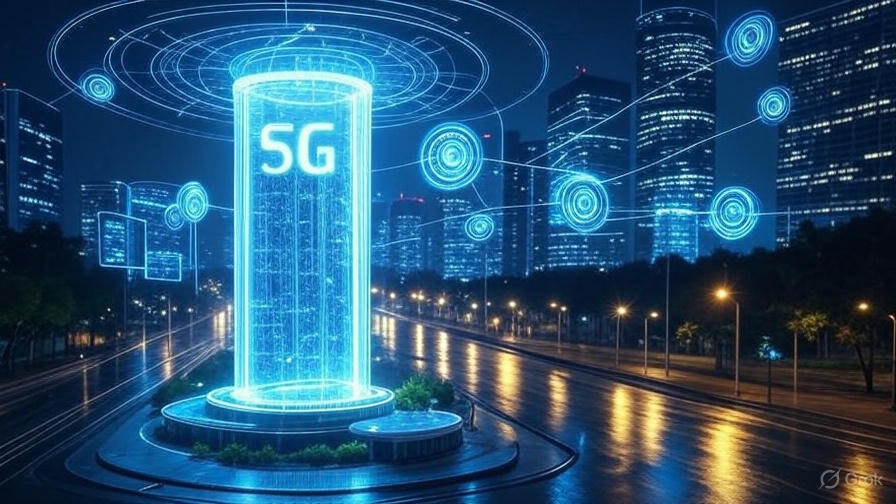Everything You Need to Know About the Future of Connectivity
As of July 2025, the global deployment of 5G networks is transforming how we connect, work, and live. This fifth-generation wireless technology promises lightning-fast speeds, ultra-low latency, and the ability to connect millions of devices seamlessly. With widespread adoption underway, understanding 5G’s potential, challenges, and implications is essential for tech enthusiasts, businesses, and everyday users. This comprehensive guide covers everything you need to know about 5G deployment in 2025, ensuring you stay ahead in the digital revolution.
What Is 5G and Why Does It Matter?
5G, or fifth-generation technology, is the latest evolution of mobile networks, succeeding 4G. It offers download speeds up to 10 Gbps—100 times faster than 4G—along with latency as low as 1 millisecond. This leap enables real-time applications like autonomous driving, virtual reality (VR), and smart cities. Beyond speed, 5G supports a massive increase in device connectivity, accommodating up to 1 million devices per square kilometer, paving the way for the Internet of Things (IoT).
The significance of 5G lies in its ability to revolutionize industries. From healthcare to entertainment, its deployment is unlocking new possibilities, making it a cornerstone of technological progress in 2025.
How Does 5G Work?
Technical Foundations
5G operates using higher frequency bands, including low-band (below 1 GHz), mid-band (1-6 GHz), and high-band or millimeter waves (24-39 GHz). Millimeter waves deliver ultra-fast speeds but have shorter range, requiring dense networks of small cells—compact antennas installed on streetlights or buildings. This contrasts with 4G’s reliance on larger, widely spaced towers.
Key Features
- Speed: Up to 10 Gbps, ideal for 8K streaming and large file downloads.
- Latency: Below 1ms, critical for real-time applications.
- Capacity: Supports millions of connected devices, from smartphones to IoT sensors.
Infrastructure Requirements
Deploying 5G demands significant investment in new infrastructure. Operators are installing thousands of small cells and upgrading existing towers, a process that began in 2019 and continues to expand globally in 2025.
The Global 5G Deployment Landscape
Leading Regions
By mid-2025, countries like South Korea, Japan, and the United States lead in 5G coverage, with over 80% of urban areas connected. China is rapidly expanding its network, aiming for nationwide coverage by 2026, while Europe targets full deployment by 2027 under EU initiatives.
Adoption Rates
Over 2 billion people worldwide use 5G, with adoption accelerating in urban centers. Rural areas lag due to infrastructure costs, but satellite technologies like Starlink are bridging the gap.
Competitive Race
The 5G rollout is a geopolitical contest, with companies like Huawei, Nokia, and Ericsson vying for dominance. This competition drives innovation but raises security concerns, influencing national policies on equipment suppliers.
Benefits of 5G Deployment
Enhanced User Experience
5G delivers seamless streaming, gaming, and video calls. Users can download a full HD movie in seconds, enhancing entertainment and productivity.
Industry Transformation
- Healthcare: Telemedicine and remote surgeries benefit from low latency.
- Manufacturing: Smart factories use 5G for real-time machine control.
- Transportation: Autonomous vehicles rely on 5G for instant data exchange.
Economic Growth
The International Telecommunication Union (ITU) projects 5G will add $13.2 trillion to the global economy by 2035, creating millions of jobs through infrastructure development and new tech sectors.
Applications of 5G in 2025
Smart Cities
5G powers intelligent traffic management, energy-efficient lighting, and waste monitoring, improving urban living. Cities like Singapore are already piloting these systems.
Virtual and Augmented Reality
With 5G’s high bandwidth, VR and AR applications flourish, from immersive gaming to virtual training programs.
Internet of Things (IoT)
From smart homes to industrial sensors, 5G connects a vast ecosystem, enabling automation and data-driven decisions.
Remote Work and Education
5G supports high-quality video conferencing and interactive learning, making remote solutions more accessible, especially in underserved regions.
Challenges of 5G Deployment
Infrastructure Costs
Building 5G networks requires billions in investment. Operators face financial pressure, often passing costs to consumers through higher plans.
Health Concerns
Some worry about millimeter wave exposure, though studies in 2025, including those from the World Health Organization, find no conclusive evidence of harm at regulated levels.
Security Risks
The shift to software-defined networks increases vulnerability to cyberattacks. Governments are implementing strict guidelines to protect critical infrastructure.
Environmental Impact
The energy demands of 5G networks and the production of small cells raise sustainability concerns, prompting research into greener technologies.
5G vs. Previous Generations
3G and 4G Comparison
- 3G: Offered 10 Mbps and 100-500ms latency, enabling basic internet use.
- 4G: Improved to 300 Mbps and 30-50ms latency, supporting HD streaming.
- 5G: Surpasses both with 10 Gbps and 1ms latency, redefining connectivity.
This evolution highlights 5G’s role as a foundation for future innovations, including 6G, expected by 2030.
Future of 5G and Beyond
Evolution to 6G
Research into 6G is underway, promising even faster speeds and integration with AI. While 5G lays the groundwork, 6G could introduce holographic communication and brain-computer interfaces.
Integration with Emerging Tech
5G will merge with AI, IoT, and edge computing, enhancing smart devices and reducing latency further.
Sustainability Efforts
Operators are exploring energy-efficient hardware and renewable energy to mitigate 5G’s environmental footprint.
How to Prepare for 5G in 2025
Upgrade Your Device
Ensure your smartphone or device supports 5G bands. Major brands like Samsung and Apple offer compatible models in 2025.
Check Coverage
Use operator maps to confirm 5G availability in your area, as rural regions may still rely on 4G.
Optimize Usage
Leverage 5G for high-demand tasks like cloud gaming or remote work, while managing data to avoid overage fees.
Myths and Facts About 5G
Myth: 5G Causes Health Issues
Fact: Regulatory bodies confirm 5G radiation is non-ionizing and safe within limits.
Myth: 5G Replaces Wi-Fi
Fact: 5G complements Wi-Fi, offering mobile flexibility rather than a full replacement.
Myth: 5G Is Only for Cities
Fact: Rural deployment is growing, supported by satellite and small-cell technologies.
Practical Tips for Businesses
- Invest in 5G-Compatible Tech: Upgrade IoT devices and networks to stay competitive.
- Train Staff: Educate teams on 5G applications to maximize efficiency.
- Partner with Providers: Collaborate with telecoms for tailored 5G solutions.
Consumer Insights for 2025
Cost Considerations
5G plans range from $50-$100 monthly, depending on speed and data caps. Look for promotional offers from carriers like Verizon or T-Mobile.
Device Recommendations
Top 5G phones in 2025 include the iPhone 17 Pro and Samsung Galaxy S25, balancing performance and price.
Network Performance
Test speeds using apps like Ookla to ensure you’re getting the promised 5G experience.
Conclusion
The 5G deployment in 2025 marks a pivotal moment in global connectivity, offering unparalleled speed, capacity, and innovation. From transforming industries to enhancing daily life, its impact is profound. While challenges like cost and security persist, the benefits—economic growth, smarter cities, and advanced technology—outweigh the hurdles. As 5G continues to expand, preparing your devices and understanding its potential will keep you at the forefront of this technological leap. Embrace the future of connectivity today and explore the endless possibilities 5G brings.
Frequently Asked Questions
1. What makes 5G faster than 4G?
5G uses higher frequency bands and advanced antenna technology, achieving speeds up to 10 Gbps.
2. Is 5G safe for health?
Yes, based on current research, 5G is safe within regulated exposure limits.
3. When will 5G be available everywhere?
Full global coverage is expected by 2027-2030, with rural areas catching up via satellite tech.
4. Do I need a new phone for 5G?
Yes, you need a 5G-compatible device to access the network.
5. How will 5G affect my daily life?
Expect faster internet, better streaming, and smarter home devices, enhancing convenience and productivity.



